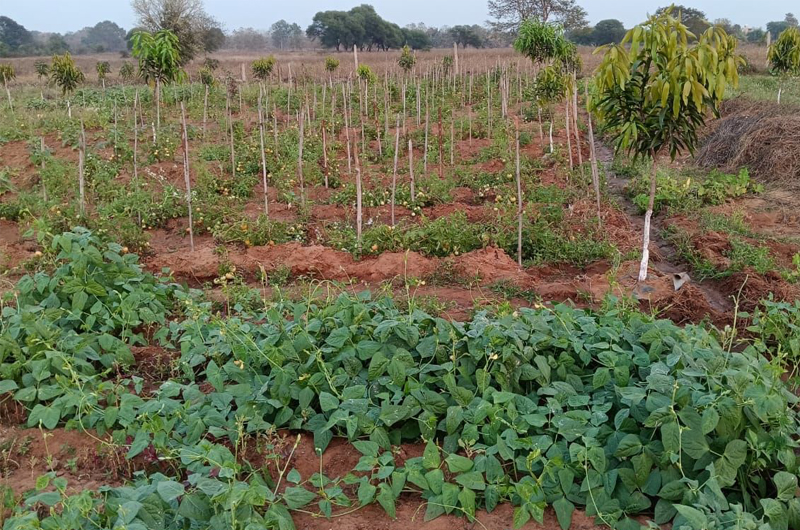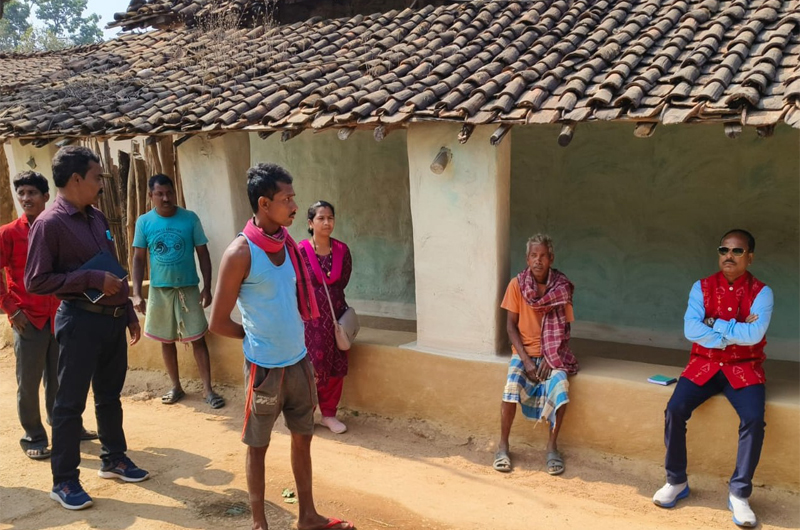Ajit Panda spoke with farmers who are well satisfied with initiatives to generate income from lands that have been lying fallow for years. He sent us this report which describes the remarkable example of utilisation of MGNREGA funds in a village in Odisha’s Khariar Block in Nuapada District
MGNREGA (Mahatma Gandhi National Rural Employment Generation Act) Schemes have the potential to serve as a significant source of income and a means of sustainable livelihood for the poor, if implemented with innovation and careful planning. A remarkable example of utilisation of MGNREGA funds can be seen in Arada Village of Odisha’s Khariar Block in Nuapada District.
Raja Sabar, a tribal from the village, was once compelled to migrate to cities in Andhra Pradesh and Tamil Nadu to find work in brick kilns. He is now the proud owner of a one-and-a-half-hectare mango orchard. “I have a total of eight acres of cultivable land, but finding steady income from farming here was a challenge. My job card not only provided me with work but also opened up an alternative source of livelihood. This is the fifth year of my mango plantation, which I established with the support of the Watershed Department, and it has now started bearing fruit,” he shared.

Raja cultivated cotton and groundnut as intercrops among the mango plants when they were still small, enabling him to earn approximately Rs 40,000 over the past three years. He plans to sow arhar (toor dal or pigeon pea) and groundnut again in the upcoming season. To enhance his future income, Raja has also planted trees like aamla, jamun, gambhari and neem along the boundary of his field. Rajeswar Sabar, another villager, has planted 200 mango plants in one acre of land. The intercrops are beans, tomato, radish and watermelon. He received Rs 8000 from his tomato crop. Other crops are now fruiting. He hopes to earn Rs 50,000 from the watermelon crop.
The mango plantation project was initiated in Arada village in 2020. It began with Raja Sabar, who agreed to the idea as soon as it was proposed to him. “The land had been fallow for a long time. When we suggested the project to Raja, he agreed,” said Biswambar Gauda, the field official of the Watershed Mission in Khariar. Raja’s wife, Bhagya Sabar, who dedicates her time to the mango plantation, shared their motivation: “We had seen mango farmers in a neighbouring village selling their produce in truckloads, so we decided to take up mango cultivation.”

Raja was not the only one to embrace mango farming in Arada village that year – three others also agreed to convert their fallow land into mango orchards. The initiative was implemented under the MGNREGA Scheme with an estimated budget of Rs 12.92 lakh, out of which Rs 9.35 lakh was allocated for wages, according to Gauda. “The project generated around 2,500 person-days of employment over four years from the year of planting, averaging about 650 days per year,” he added. It was enough to generate more than 150 days of employment for every family which took up this venture, because most of the work was carried out by the family members of the beneficiaries. Bhagya explained, “We handled everything from digging pits and manuring to planting and regular watering, often carrying water on our heads from the nearby river.”
Additional employment opportunities were also created for the beneficiaries through a field-bunding programme under MGNREGA. The effort in 2020 led to more households planting mango orchards on their uplands, which were previously used occasionally for cultivating cotton or guruji. “Four more households approached the Watershed Mission for support under the project, and they were subsequently included in 2021-22 and 2023-24,” said Gauda.

Mango orchards in Arada now cover eight hectares, with 3,200 thriving plants, backed by an investment of approximately Rs 26 lakh, of which Rs 22.42 lakh has been allocated to wages. After ensuring three to four years of dedicated care and supervision, the Mission has handed over the plantations from the first and second phases to the beneficiaries. Over the past five years, the projects have generated 6,500 person-days of employment, providing stable livelihoods for 12 households actively engaged in the initiative. These farmers have also participated in other MGNREGA projects, such as field-bunding and land development, further enhancing their earnings. Beneficiaries report that their income from the scheme alone ranged between Rs 30,000 and Rs 40,000 a year, helping them meet their livelihood needs, healthcare expenses, and children’s education. They earned extra income by cultivating vegetables as intercrops too.
“We haven’t calculated the exact income our efforts will yield, but we are deeply grateful to the officials who guided us out of distress migration (dadan) and the hardships we faced while working in kilns,” the farmers said. The beneficiaries have now become role models within the community, inspiring more farmers to take up plantation activities. Encouraged by their success, three more farmers have expressed interest in joining the initiative next year, and officials are planning to include them in the scheme. “The district administration has been striving to reach out to people in distress by providing employment though MGNREGA. We are confident of arresting migration in the coming days” said Nuapada District Magistrate Madhusudan Dash.
(The writer is a photojournalist based in Bhubaneswar.)



 from Webdoux
from Webdoux